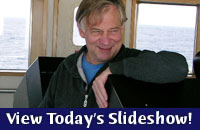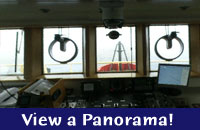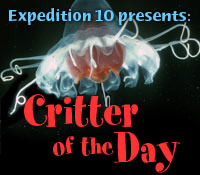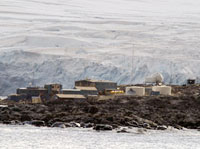|
   Today's Weather Partly Sunny Latitude: transiting Longitude: transiting Sea State:2 Swell Height: 2-3 
  Read the new Hot Topic: Life on Palmer Station March 6, 2006 by Kate Madin From the bridge of the L. M. Gould, Chief Mate Kevin LeBouef scanned the sea and horizon. He checked the radar and course, not seeming to worry about anything. “Every day is a good day,” he said. “If I can’t control it, I don’t worry about it.” Control on a ship resides on the bridge, where the captain steers the ship and charts its course, high above the deck. On the Gould, Captain Scott Flanagan shares round-the-clock duties with the chief mate, Second Mate David Morse, and Third Mate Larry Brissette. Kevin, from coastal Louisiana, learned to love the ocean early, and has a boat at home. To become chief mate, you start at the bottom, he says. “You need three years of sea service to qualify to take the classes you need, to work toward a mate’s license.” For Dave Morse, it’s been a long, circuitous road to here. His background is fishing, from his own boat in Point Judith, Rhode Island, to captaining a 101-meter (300+ feet) Russian vessel in the Southern Ocean—though he didn’t speak Russian. “I was already down here, and was in the right place at the right time to be hired for the Gould,” he said. All three mates love seeing different places, lands, and people. “I like meeting the scientists who come out on the Gould,” said Dave. “When I went to college, I was going to be a lawyer. But I love it here. I get to see every day what people pay a great deal to see from a cruise liner—the Antarctic coastline.” Larry Brissette, along with his father, grandfather, and great-grandfather, piloted ships in the Great Lakes. With a spread of controls arrayed in front of the Gould’s pilot’s chair, he listed the navigational systems and back-ups. “There’s a lot of redundancy,” he said, “because you just can’t get a repairman out here!” Yet he finds it serene on the bridge, and he pointed out albatrosses soaring back and forth across the bow. This life can be a challenge because they are at sea so much. In fact, they’re at sea twice or three times as much as they’re ashore. “It takes a strong family to do this,” said Kevin, who has a wife and children, and is away maybe eight months a year. “But I have the travel bug. I love going different places to see the cultures and the people. I worked on land, and couldn’t stand the 30-minute commute! Here I wake up and I’m already at work.” But this is Kevin’s last science cruise aboard the Gould. His house was damaged by hurricanes Katrina and Rita last year. He is rebuilding it himself, and will be working closer to home. “I’ll still be on ships,” he said. “But I’ll miss this. Where else can you see scenery like Antarctica?”
|
|||||||||||||||||||||||||||||||||||||||||||||||||||||||||||||||||||||||||||||||||||||||||||||
Mailing List | Feedback | Glossary | For Teachers | About Us | Contact
© 2010 Dive and Discover™. Dive and Discover™ is a registered trademark of Woods
Hole Oceanographic Institution
